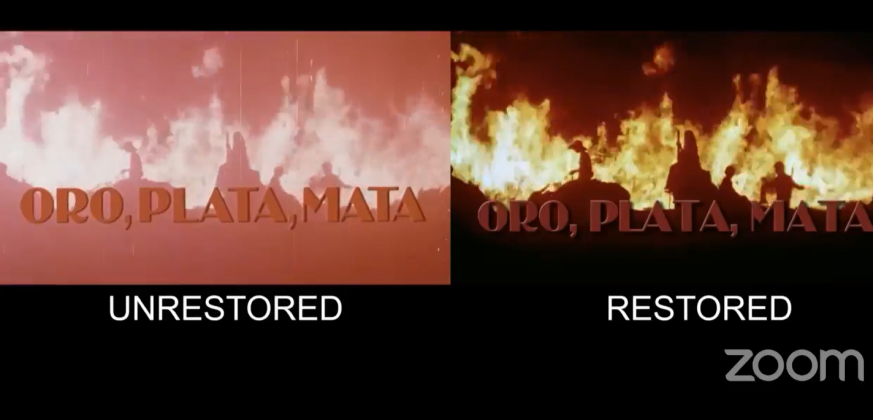How ABS-CBN continues to save PHL film heritage
Project endangered by pandemic lockdowns and network franchise loss
LOST records are lost histories. Like books, films document stories of our history, and serve as mirror to our society. A recent webinar discussed an effort to save these celluloid pieces of history.
The Financial Executives Institute of the Philippines (FINEX) Philippines Arts and Culture committee hosted the webinar “Ganito Tayo Noon… Sagip Pelikula: Restoring Our Cinematic Heritage” on Jan. 27, which was streamed via Facebook.
Philippine cinema goes back from 1919 when the “Father of Philippine Movies” Jose Nepumuceno premiered his first silent narrative film, Dalagang Bukid (1919), starring bodabil (vaudeville) performer and future National Artist for Theater and Music Atang de la Rama, and Marcellano Ilagan. It is estimated that since then, more than 8,000 movies were shot on film until movie production went fully digital in 2012.
Within that span of time, there were two so-called “Golden Ages” of Philippine movies. In his presentation, Leonardo “Leo” P. Katigbak, who is Head of Film Archives & Restoration at ABS-CBN Corp., said that the first was in the 1950s with the films from major studios like Sampaguita, LVN Pictures, Premiere Productions, and Lebran International. The second golden age is considered to have happened in the 1970s, when films focused on more socio-political themes.
But many of these early films are gone — of the 8,000+ movies shot on film, only around 2,000 have surviving copies.
Prior to the advent of the Internet and long before online streaming, film producers saw no aftermarket for the films after their theatrical releases — they had no incentive to preserve the films. Most of the films stock deteriorated due to the country’s humid weather and the need for expensive maintenance. The type of film base used also made it difficult to preserve and store properly.
The earliest film base, which was used until the 1950s, was made of nitrate which were highly flammable and unstable. Said Mr. Katigbak. Another was acetate (used from the 1920s to the 1980s) which quickly deteriorated. It was only in the mid-1990s that polyester (which was unbreakable by human hands) was used.
It was only in 2008 that film producers started going fully digital, he said. Some of the last movies shot on film were Wenn Deramas’ This Guy’s in Love with U Mare!, Ruel S. Bayani’s One More Try, and Olivia Lamasan’s The Mistress, which premiered in 2012.
SAVING OUR FILMS
To preserve the Philippine’s film heritage, the ABS-CBN Film Archives, which was established in 1994, started exploring the restoration of old films in 2011. The following year, Ishmael Bernal’s classic Himala (1982) was released as the first digitally restored film from the ABS-CBN Film Archives and Central Digital Lab project. In 2015, the project launched the “Sagip Pelikula” campaign to further raise awareness. In 2021, the project marked its 10th anniversary with over 200 films restored.
Mr. Katigbak differentiated between film preservation, revisionism, and restoration.
“Preservation is ‘as is where is,’” Mr. Katigbak said. No interventions are made to improve film quality, it is simply to preserve what you have. “You don’t want the film to deteriorate any further,” he said.
Revision, he said, is where elements are changed or improved. “[This is where] directors were making certain changes [to their works] that they felt were originally wrong or not able to do.”
“But for our purposes, what we want is really, pure restoration. So, it’s bringing it back to what we think was the original intent of the creators,” Mr. Katigbak said.
“We have our own vaults ABS-CBN [where] we make sure that it is humidity controlled, and quality controlled. The cans (of film) are often checked to see if there is vinegar syndrome,” Mr. Katigbak said.
Vinegar syndrome is a form of degradation that occurs with cellulous acetate film, characterized by an obvious vinegar smell due to the release of acetic acid by the degrading film.
While the ABS-CBN Film Archives are capable to cleaning smudges, discoloration and misalignments in house, major restoration — color grading and HD, 2K, 4K conversion — are done in collaboration with international companies such as the Italian film restoration laboratory L’Immagine Ritrovata, and Japanese audiovisual conservation and digitization company Tokyo Koon Co.
Mr. Katigbak noted that the cost of restoring one film ranges from P500,000 to P100 million.
“There are 24 frames per second of film,” Mr. Katigbak explained. “So, when you talk about the film that [runs at] 90 minutes… You’re in that range of about 150 to 200,000 frames that you need to physically fix.”
In choosing which films to restore, the ABS-CBN restoration team focuses on those that earned awards and recognition, were box office hits, or present a cultural snapshot of the country.
Mr. Katigbak said that when they started the project, the team did not want to be celebrity-centric but writer- and director-centric. The team had a master list of priority titles but had to adjust depending on availability and condition of the film.
CHALLENGES IN 2020
The film restoration project slowed down in March 2020 because of the lockdown due to the COVID-19 pandemic. Employees had to work remotely.
The project also suffered a huge blow when ABS-CBN’s broadcast frequency franchise was denied in May 2020. In August that year, many of the network’s departments were forced to close, and the ABS-CBN Archives had to downsize.
“We made a presentation with management to show that there was still a need to preserve, or at least keep a smaller group to save in the movies,” Mr. Katigbak said.
The 14-member team shrank to five, and majority of the work was limited to what they can accomplish in-house — no more restoration work done abroad.
“A lot of the movies that we release up to last year, were actually movies that were completed before we were shut down,” he said. “But all of these lockdowns and limiting work from home are also affecting us because our work is in the office.”
“Fortunately, we have our scanner,” Mr. Katigbak said, adding they are now more focused on digital scanning and enhancements of films.
REACHING AUDIENCES AND MOVING FORWARD
With the network shutdown, and long closure of cinemas, distribution on online platforms was explored as a way to reach a wider audience.
“So, we explore as much as we can,” Mr. Katigbak said. “It’s not just, for example, the platforms owned and operated by ABS-CBN.”
The digitally restored films are accessible on Apple TV, Netflix, and KTX.ph. In the past year, some titles were also shown for free through the ABS-CBN film restoration Facebook page.
“People generally will watch the movies regardless. Unless there is awareness, how will they even know to look for it and to ask for it?” Mr. Katigbak said.
As of Jan. 27, the project has 194 digitally restored titles which are accessible in 64 territories.
“We’re aggressively putting them out [on various online platforms]. And we’re enjoying the fact that there’s a lot of demand for them, both locally and internationally,” Mr. Katigbak said. “So hopefully, that’s the one that’s going to continue. But as with anything, you need new products in the pipeline, so that you sustain interest.”
The ABS-CBN film restoration project is currently working on the digital scanning and enhancement of Giliw Ko (1939) and Triplets (1960).
“We need to look back at cinema as a record of our identity and who we are as a Filipino. It’s the one that really captures it in all its vibrancy, more than a static photo,” Mr. Katigbak said.
“If we don’t save our movies, we will eventually forget them and that is one of the greatest tragedies that can happen. Because they are not just entertainment, they are a reflection of who we are and our identity as a people,” he said.
To watch the digital restored films, visit http://itunes.com/abscbn, https://www.ktx.ph/. For more information, visit https://www.facebook.com/filmrestorationabscbn/. — Michelle Anne P. Soliman





